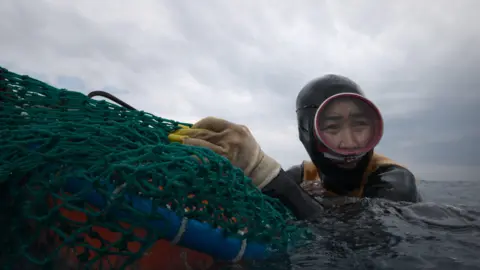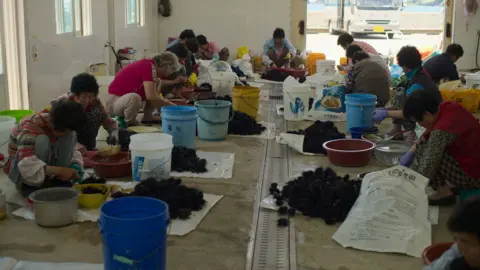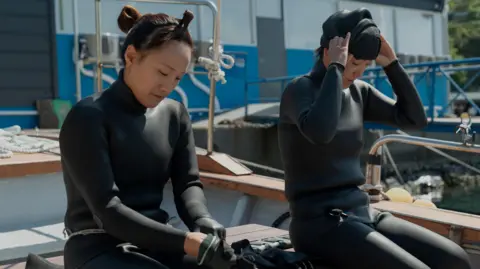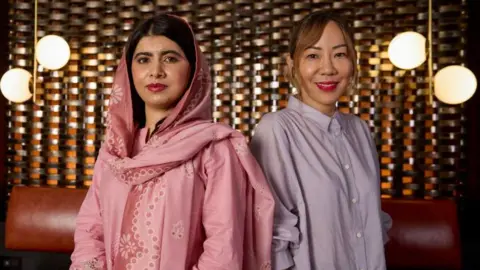 Apple
Apple What if someone told you mermaids were real?
Forget the fish tails, we mean women capable of holding their breath for minutes on end as they dive under the sea several hundred times a day.
These are the haenyeo divers of South Korea, a community of women from Jeju Island who have been free-diving (without oxygen) to harvest seafood for centuries.
Now, with most of them in their 60s, 70s and 80s, their traditions and way of life are in danger as fewer younger women take up the profession, and with the ocean potentially changing beyond recognition.
It’s these facts that prompted US-Korean film-maker Sue Kim to team up with female education advocate and Nobel Peace Prize winner Malala Yousafazai to share their story with the world.
The daughter of Korean immigrants, US-born Kim first came across the haenyeo when she was a child, holidaying in South Korea.
“I was so struck by them for the same reasons that you see in the film – they were so incredibly bold and vibrant and confident. They were also so loud… fighting and laughing, and they just gave off this very big energy and occupied their space so unapologetically,” says Lee.
“I just fell in love with that entire vibe and big energy when I was a little girl. And so I grew up staying fascinated with them. They were a version of Korean womanhood that I was inspired by and wanted to emulate,” she adds.
“I was so shocked that I did not know about the haenyeo, like so many people did not know, I said yes straight away,” explains Malala, who was a producer on the film.
 Apple
Apple“The story really took on an urgency about 10 years ago when I found out that this was probably the last generation of the haenyeo,” explains Lee. “It became more of an urgent mandate to make sure someone documented… while we still had them and while they could still tell us their own story in their own words.”
The film follows the women going about their gruelling work during the harvest season and examines the challenges they face both in and out of the water.
They head out to dive at 6am daily. They hold their breath for a couple of minutes, come back up to the surface and go back down again – between 100 and 300 times a session.
Just imagine the fitness levels. They harvest for four hours and then spend another three or four shelling and preparing their catch.
There are various theories as to why women began to take over this traditionally male job so many years ago. The Visit Jeju website states that the number of men was low overall in the population due to a high portion of them dying on the rough seas while boat fishing.
As a result, there weren’t many men to harvest the ocean, so women gradually took over the job.
‘Sad grandma trope’
This is the first major documentary about the haenyeo and Kim says it was hard to gain access.
“The haenyeo communities, they’re very insular,” she explains.
“They’re rural communities that live in fishing villages. They don’t interact with the cities of Jeju much.”
Kim found a researcher who had a history with NGOs and had contacts in the community.
“So this woman… introduced us, then I went down and I basically spent two weeks with… the Haenyeo communities and really gaining their trust. And I did that by mostly listening.
“They actually wanted to talk about all the things that were happening to them.
“They wanted to talk about the fact that they felt that they were on the verge of extinction. They wanted to talk about what was happening to the ocean that no-one seemed to know about or care about.”
Kim says she had to reassure the women that she wouldn’t stereotype them or pity them for working into old age.
“They love working! They think they’re so strong and empowered by doing so.”
Kim told them she would show them in their “true power.”
“‘I promise I will not take on this sad grandma trope because that’s not how I see you, I see you as heroes’,” she explained to the group.
“After that, we became a family.”
 Apple
AppleThe risks are big. There is no insurance available for the job, as it’s too dangerous. And now the ocean – and the women’s livelihood – is under threat.
Global warming is resulting in less sea life, particularly in shallow water; diving deeper is more difficult without oxygen.
Much of the film focuses on the women’s protests against the radioactive water from Japan’s Fukishima plant being discharged into the ocean (Jeju borders Japan), which takes one of the haeneyeos, Soon Deok Jang, directly to the UN’s Human Rights Council in Geneva.
The message from experts is, overwhelmingly, that the release is safe and it got the green light from the International Atomic Energy Agency – but not all scientists agree on the impact it will have.
While the haenyeo do harvest marine life, there are regulations in place about when they’re allowed to harvest certain seafood, which helps to protect the ecosystem.
Another reason they don’t use oxygen tanks is because “they believe that by holding their breath, that will allow them the natural amount of marine life that they should harvest”, Kim explains, which helps avoid overfishing.
 Apple
ApplePerhaps the bigger threat though, is from within, with fewer younger women choosing to pursue this difficult profession.
A training school was set up in the early 2000s to try to stem the dwindling numbers but only 5% of those attending go on to become haenyeos.
All is not lost though. The film introduces us to two young women from another island who have found a following on social media and point out the flexible hours the job can offer around family life. One of them had to learn to swim at the age of 30 to do the job.
The older women meet with them for festivals and protests – they call them “their babies” while they are named “aunties” in return.
Yousafzai is inspired: “When I look at the haenyeo and how they work together, it just reminds me of the collective work that women are doing everywhere else, including the advocacy that Afghan woman are doing to raise awareness of the systematic oppression they are facing.”
“When a girl is watching this documentary, I want her to believe in herself and realise that she can do anything. She can stay under the water for two to three minutes without oxygen,” she says. “And of course I still have to take some swimming classes to learn how to swim! I’m at point zero, but it has inspired me to consider swimming.”
The Last of the Sea Women is available on Apple TV+ from 11 October 2024.

